Home » Earth’s Magnetosphere physics
Category Archives: Earth’s Magnetosphere physics
Current state and perspectives of Space Weather science in Italy
Papers from SWICo members
Plainaki Christina, Antonucci Marco, Bemporad Alessandro, Berrilli Francesco, Bertucci Bruna, Castronuovo Marco, De Michelis Paola, Giardino Marco, Iuppa Roberto, Laurenza Monica, Marcucci Federica, Messerotti Mauro, Narici Livio, Negri Barbara, Nozzoli Francesco, Orsini Stefano, Romano Vincenzo, Cavallini Enrico, Polenta Gianluca, Ippolito Alessandro
This paper presents a brief state-of-the-art in Space Weather science in Italy and discuss some ideas on a long-term plan for the support of future scientific research in the related disciplines. Italian teams contributed in the advancing of our knowledge on the properties and evolution of the Space Weather phenomena with observational campaigns from space and from the ground. Numerous Space Weather forecasting and now-casting modeling efforts have resulted in a remarkable add-on to the overall progress in the field, at both national and international level. The Italian Space Agency participated several times in space missions related to Space Weather; indeed, the development of new instrumentation for future Heliophysics and Space Weather space missions will be very important for the Italian scientific and industrial communities.
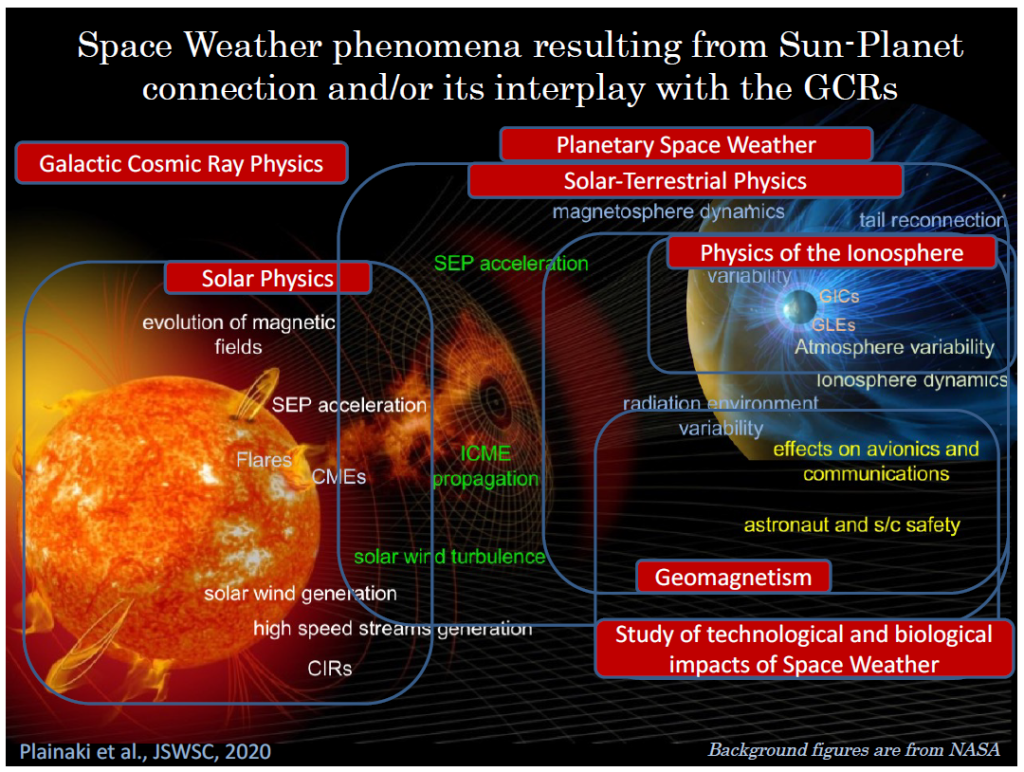
The Italian Space Agency aims to assess the possibility to develop a national scientific Space Weather data centre to encourage synergies between different science teams with interest in the field and to motivate innovation and new mission concept development. Alongside with the proposed recommendations, this paper also discusses how the Italian expertise could complement international efforts in a wider international Space Weather context.
Publication: Plainaki C., Antonucci M., Bemporad A., Berrilli F., Bertucci B., Castronuovo M., De Michelis P., et al., 2020, JSWSC, 10, 6. doi:10.1051/swsc/2020003. https://www.swsc-journal.org/articles/swsc/abs/2020/01/swsc190014/swsc190014.html
Can an impulsive variation of the solar wind plasma pressure trigger a plasma bubble? A case study based on CSES, Swarm and THEMIS data
Papers from SWICo members
M. Piersanti, M. Pezzopane, Z. Zhima, P. Diego, C. Xiong, R. Tozzi, A. Pignalberi, G. D’Angelo, R. Battiston, J. Huang, P. Picozza, Y. Rui, X. Shen, R. Sparvoli, P. Ubertini, Y. Yang, S. Zoffoli
During the August 25, 2018 geomagnetic storm, the new borne CSES-01 satellite and the Swarm A satellite detected a really large equatorial plasma bubble (EPB) in the post-midnight sector over western Africa. We investigated the features of this deep ionospheric plasma depletion using data from the Langmuir probes on-board CSES-01 and Swarm A satellites, and data from the high-precision magnetometer and the electric field detector instruments on-board CSES-01. Using also plasma and magnetic field data from THEMIS-E satellite we found that, during the passage of the magnetic cloud that drove the geomagnetic storm, an impulsive variation lasting about ten minutes characterized the solar wind (SW) pressure.
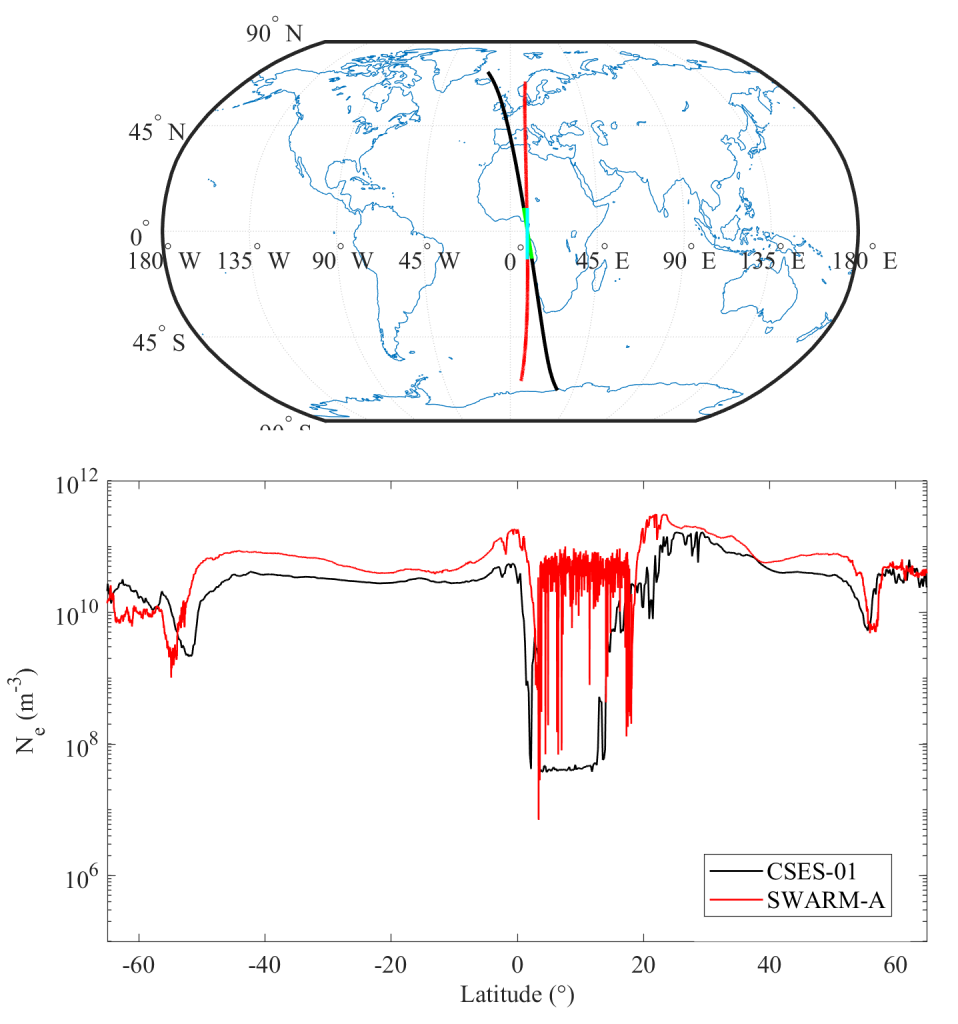
The analysis of the delay time, between the occurrence of such impulsive variation and the detection of the plasma bubble, suggests a possible link between the SW pressure impulsive variation as identified by THEMIS-E and the generation of the EPB as detected by CSES-01 and Swarm A. We put forward the hypothesis that the SW pressure impulsive variation might have triggered an eastward prompt penetrating electric field that propagated from high to equatorial latitudes, overlapping in the nightside region to the zonal westward electric field, causing either a reduction or an inversion, at the base of the EPB triggering.
Publication: M. Piersanti, M. Pezzopane, Z. Zhima et al., Can an impulsive variation of the solar wind plasma pressure trigger a plasma bubble? A case study based on CSES, Swarm and THEMIS data, Advances in Space Research 67, 35–45, 2021. https://doi.org/10.1016/j.asr.2020.07.046
Forecasting SYM‐H Index: A Comparison Between Long Short‐Term Memory and Convolutional Neural Networks
Papers from SWICo members
F. Siciliano G. Consolini, R. Tozzi, M. Gentili, F. Giannattasio, and P. De Michelis.
Geomagnetic indices are proxies of the geomagnetic disturbances observed on the ground during geomagnetic storms and substorms. So, their forecasting represents a key point to develop warning systems for the mitigation of possible effects of severe geomagnetic storms on critical ground infrastructures. Here, we forecast SYM‐H index using two artificial neural network models based on two conceptually different networks: the Long Short‐Term Memory (LSTM) and the Convolutional Neural Network (CNN). Both networks are trained with two different sets of data: 1) interplanetary magnetic field (IMF) components and magnitude, and 2) interplanetary magnetic field components and magnitude and previous SYM‐H values. Specifically, we selected 42 geomagnetic storms among the most intense occurred between 1998 and 2018.
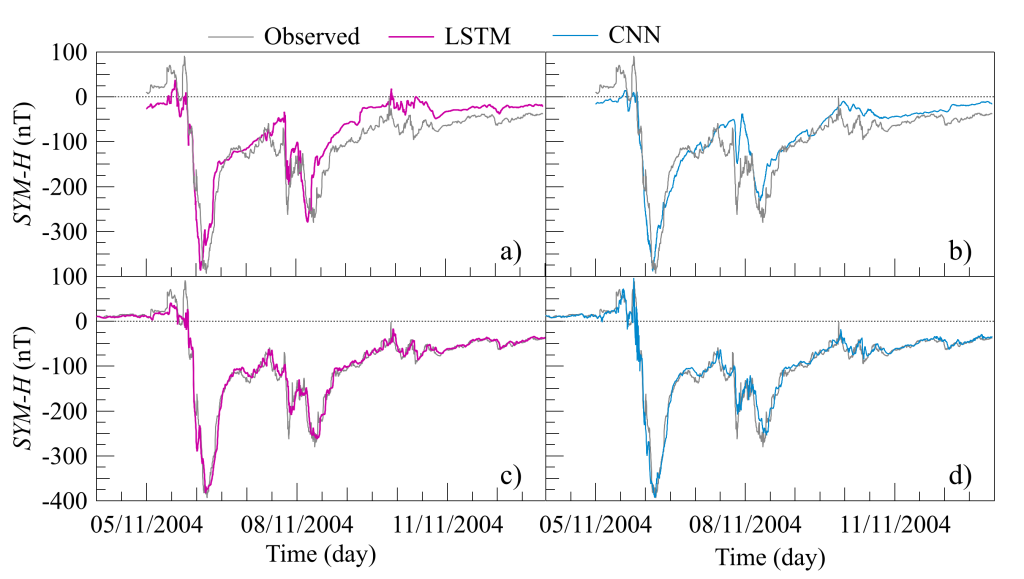
The performance of the two models has been compared thus pointing out the peculiarity of each model. In summary we have found that: 1) both networks are able to well forecast SYM‐H index 1 hour in advance, with values of the coefficient of determination R2 larger than 95%; 2) when using the data set that includes SYM-H index the model based on LSTM is slightly more accurate than that based on CNN; 3) differently, when using the data set consisting of IMF values only the model based on CNN displays a higher accuracy than that based on LSTM.
Publication: F. Siciliano G. Consolini R. Tozzi M. Gentili F. Giannattasio P. De Michelis, Forecasting SYM‐H Index: A Comparison Between Long Short‐Term Memory and Convolutional Neural Networks, Space Weather, 19 (2), 2021. https://doi.org/10.1029/2020SW002589
Detection Capability of Flux Ropes during the Solar Orbiter Mission
Papers from SWICo members
Telloni, Daniele; D’Amicis, Raffaella; Bruno, Roberto; Carbone, Francesco; Perrone, Denise; Zank, Gary P.; Zhao, Lingling; Nakanotani, Masaru; Adhikari, Laxman
Flux ropes are interplanetary magnetic helical structures that are receiving increasing attention because of their likely role in magnetohydrodynamic (MHD) processes as well as their impact on space weather science. A very promising and powerful approach to address their investigation and characterization is based on wavelet spectrograms of the invariants of the ideal MHD equations.
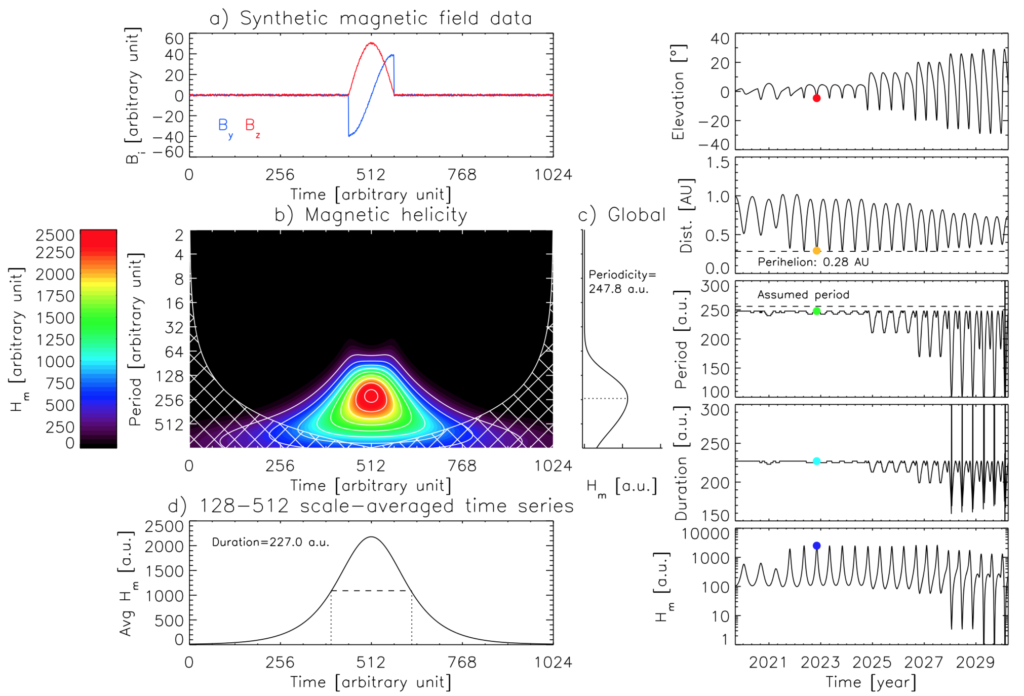
The accuracy of this method to infer flux rope properties depends on the proper evaluation of the direction of propagation of the flux rope itself, which is often difficult to assess. We present a numerical test of the reliability of this diagnostic technique, by simulating a synthetic flux rope of fixed size and propagation direction along the Solar Orbiter orbit, that is very elongated and inclined with respect to the orbital plane. We find that when the flux rope is crossed for less than 50% of its width, the procedure becomes unreliable. Quantitative information on how to properly recover the flux-rope intrinsic properties is provided.
Publication: Telloni D., D’Amicis R., Bruno R., Carbone F., Perrone D., Zank G. P., Zhao L., et al., 2020, ApJL, 899, L25.
https://iopscience.iop.org/article/10.3847/2041-8213/abacc4
Study of the Influence of the Solar Wind Energy on the Geomagnetic Activity for Space Weather Science
Papers from SWICo members
Telloni, Daniele; Carbone, Francesco; Antonucci, Ester; Bruno, Roberto; Grimani, Catia; Villante, Umberto; Giordano, Silvio; Mancuso, Salvatore; Zangrilli, Luca
This paper addresses the investigation of the interaction of the solar wind energy with the Earth’s magnetosphere, by studying its correlation with the disturbance storm time (Dst) index, a proxy of the geomagnetic activity. Some relevant parameters of the solar wind (the bulk speed and the z-component of the interplanetary magnetic field) are explored in the energy-Dst space.
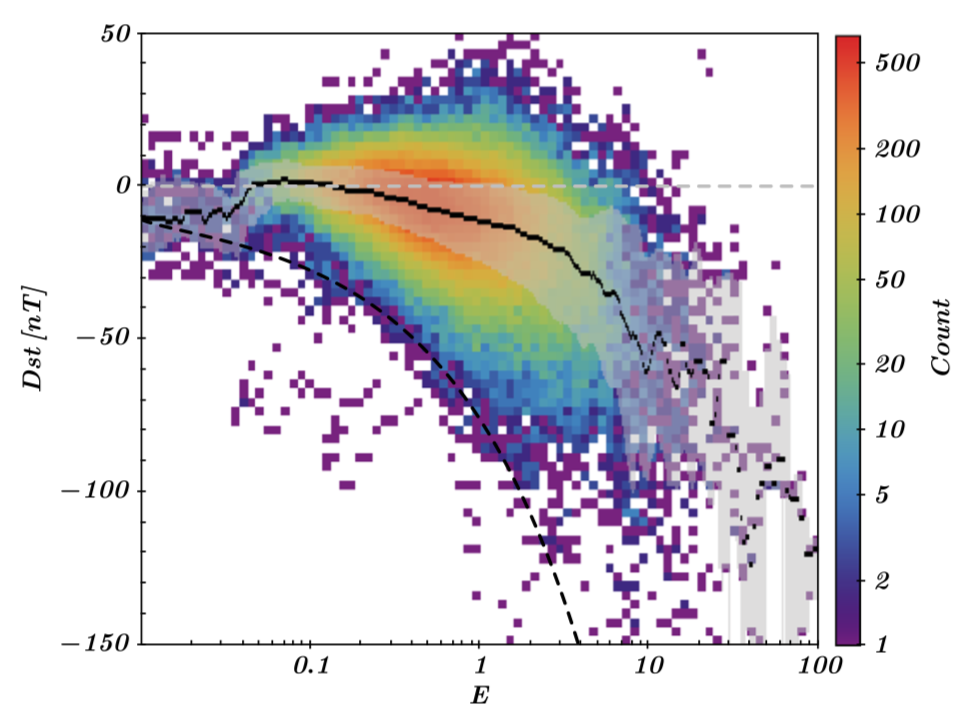
It results that (I) the solar wind energy and the geomagnetic activity are strictly related, with the coronal mass ejections representing the most energetic and geoeffective driver; (II) the slow solar wind has negligible effects on Earth regardless of its energy content, whereas high-speed streams may induce severe geomagnetic storming depending on the advected energy; and (III) while at low and mid energies, geomagnetic disturbances are induced provided the magnetic reconnection between the interplanetary and terrestrial magnetic fields occurs, high-energy solar wind plasma can impact Earth even without reconnecting with the geomagnetic field at the dayside magnetopause. The most significant result in the framework of space weather science resides in the observational evidence that the Earth’s magnetosphere has a maximum response to the energetic content of the solar wind, which leads to the derivation of an empirical law allowing the proper forecast of the upper limit of the intensity of any geomagnetic disturbance on the basis of the solar wind energy derived in situ at the Lagrangian point L1.
Publication: Telloni D., Carbone F., Antonucci E., Bruno R., Grimani C., Villante U., Giordano S., et al., 2020, ApJ, 896, 149.
https://iopscience.iop.org/article/10.3847/1538-4357/ab91b9/pdf
Detection of Coronal Mass Ejections at L1 and Forecast of Their Geoeffectiveness
Papers from SWICo members
Daniele Telloni , Ester Antonucci, Alessandro Bemporad, Tiziano Bianchi, Roberto Bruno, Silvano Fineschi, Enrico Magli, Gianalfredo Nicolini, and Roberto Susino
A novel tool aimed to detect solar coronal mass ejections (CMEs) at the Lagrangian point L1 and to forecast their geoeffectiveness is presented in this paper. This approach is based on the analysis of in situ magnetic field and plasma measurements to compute some important magnetohydrodynamic quantities of the solar wind (the total pressure, the magnetic helicity, and the magnetic and kinetic energy), which are used to identify the CME events, that is their arrival and transit times, and to assess their likelihood for impacting the Earths magnetosphere.
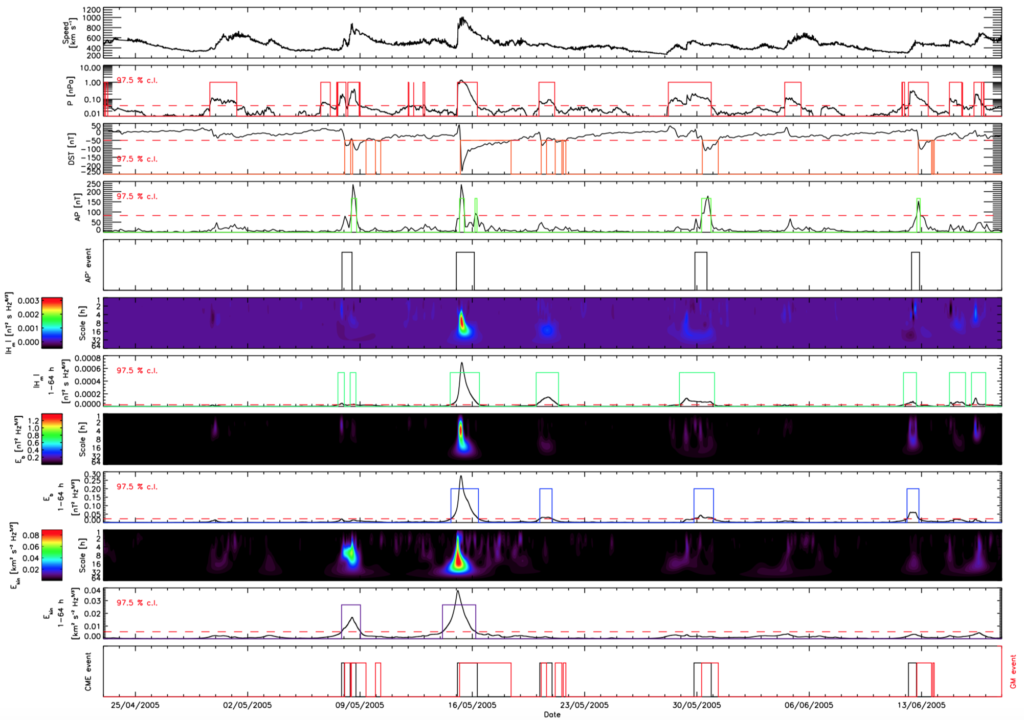
The method is essentially based on the comparison of the topological properties of the CME magnetic field configuration and of the CME energetic budget with those of the quasi-steady ambient solar wind. The algorithm performances are estimated by testing the tool on solar wind data collected in situ by the Wind spacecraft from 2005 to 2016. In the scanned 12 yr time interval, it results that (i) the procedure efficiency is of 86% for the weakest magnetospheric disturbances, increasing with the level of the geomagnetic storming, up to 100% for the most intense geomagnetic events, (ii) zero false positive predictions are produced by the algorithm, and (iii) the mean delay between the potentially geoeffective CME detection and the geomagnetic storm onset if of 4 hr, with a 98% 2-8 hr confidence interval. Hence, this new technique appears to be very promising in forecasting space weather phenomena associated to CMEs.
Publication: Telloni D., Antonucci E., Bemporad A., Bianchi T., Bruno R., Fineschi S., Magli E., et al., 2019, ApJ, 885, 120. doi:10.3847/1538-4357/ab48e9
https://iopscience.iop.org/article/10.3847/1538-4357/ab48e9/pdf
